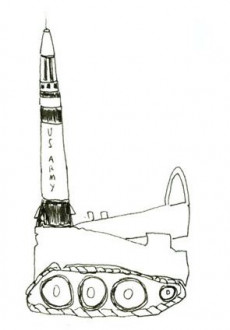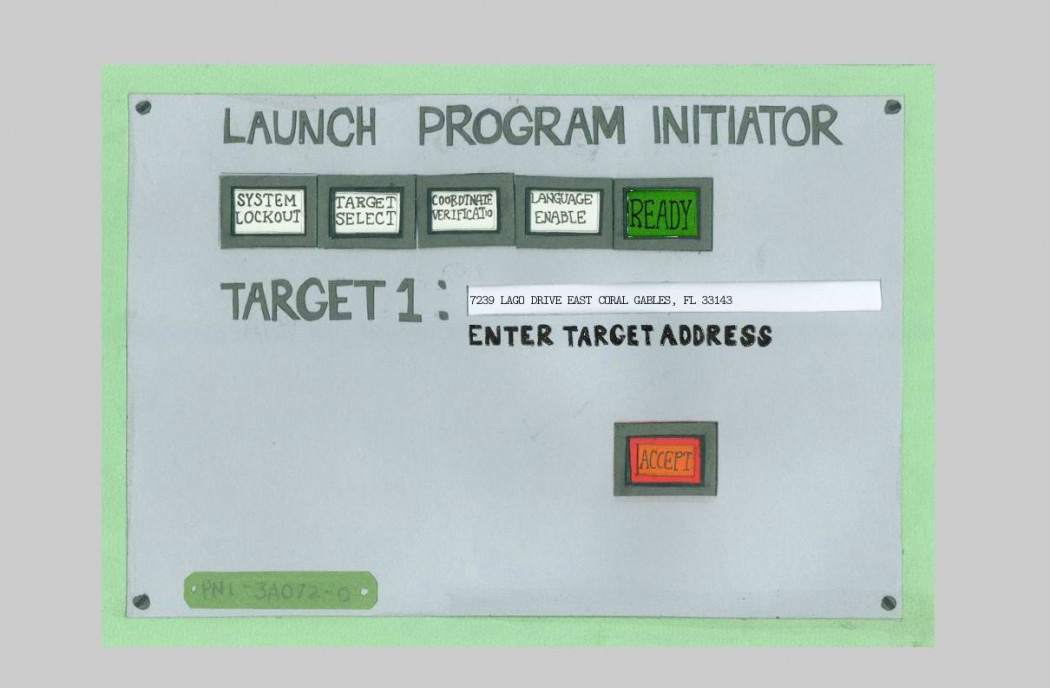Lisi Raskin, Warning Warum
Launch date: November 13, 2009, Artist Web Projects
Enter target address, select weapon, accept, fire shot, wait.
About the Project

Flash required, please turn on your sound.
Special thanks to Smita Sathe for programming
Funding for this series has been provided by The New York State Council on the Arts.
Due to a change in Google's API, this project stopped working and will not be restored at the request of the artist.
I remade a non-functioning control panel originally designed to send a nine-megaton nuclear weapon to a clandestine enemy target. The sheer violence implicit in this object, and by extension in its replica, is worthy of some contemplation. - Lisi Raskin
For her first web-based artwork, Warning Warum, Lisi Raskin presents visitors with the ability to virtually detonate an atomic bomb at an address of their choice. The mapping functionality included in Raskin's project was once available on the web as part of a PBS website for the 1999 film "Race for the Superbomb." The website still exists, but the mapping function was removed post 9-11, a time which marked a shift from Cold War nuclear fears to the fears of nuclear bombs in the hands of terrorists. Raskin's artistic restoration of this functionality to the web features a hand-crafted replica she made of the nuclear control panels she saw while visiting the Titan Missile museum in Green Valley, Arizona, last year. This was one of several destinations that Raskin visited during a research trip for "Mobile Observation," a project she did for the Center for Curatorial Studies at Bard College that focused on nuclear history in relation to land use in the American West.
Raskin's interest in "the nuclear sublime" and fascination with Cold War history and culture is not new. Having grown up in the 80s when popular culture was rife with apocalyptic visions in film, television and music, imagining annihilation was almost inescapable. Rather than suppress the abject terror of an pre-adolescent certain of the imminent arrival of Russians missiles, however, she taps into these childhood fears and attempts to retain their intensity as a creative tactic, sublimating them in a practice which ranges from representational drawings and installations to performance to works where abstraction plays an growing role, such as the immersive sculptural environment, Armada, she created for the Blanton Museum of Art in Austin, Texas, this year.
Raskin's work is deliberately imprecise. Her rejection of any attempts at "mastery," combined with her choice of elementary-school materials such as construction paper, crayons and glue, are conducive to transporting the viewer to a time when our adult skills of managing fear were not fully developed, and our abilities to keep our imagination in check even less so. Raskin is interested in the tension between what is real and what is imagined, here in connection to the transgressive nature of imagining death on a massive scale. Raskin sees the potential in this kind of imagination to allow for empathy and critical discourse to come into play. But even transgressive thoughts have taken on the feeling of criminality in the post-9-11 "if you see something, say something" self-policing environment. Given the lack of privacy inherent in communication via the internet, arguably the lack of privacy anywhere in the post-Patriot Act era, the only place transgressive thoughts are secure is in your head. The government seems complicit in a wider cultural desire to avoid imagining death and disaster. Policies like no photos of dead US soldiers in Iraq make it easier for the public to keep the war out of sight and out of mind, hence a resigned complacency. Raskin's work, by contrast, is a rejection of denial.
Raskin's unthreatening aesthetic and almost playful approach is a stark contrast to her subject matter. The lo-fi, game-like interface, complete with the soundtracks of the artist mimicking an absurd siren, radar sounds, and a massive explosion, paradoxically make the exercise of "blowing up" a target more friendly and compelling, yet somehow more discomforting than if the mapping were a simple Google map interface. Two animations punctuate the launch states. The first, which appears after selecting a weapon, shows a manic rendering of the title words, Warning Warum, breaking apart, spinning, and reconvening while the siren sound grows more frantic. Warum is the German word for why, meaning that technically the title of Raskin's project is a question, posed using the language of the country that occasioned 20th century contemplation about humanity's capacity for annihilation.
Her second animation follows the detonate page. In this one, we see a stop-motion animation of cut out trianges and sights, moving in a manner which feels both calculated and frightningly random at the same time. The duration of this animation is surprising to visitors conditioned to expect instant results on the web. It affords a moment to consider our dual role of perpetrator and victim on the nuclear stage, while we await the map that shows the concentric rings of potential devastation.
At the end of her book Mobile Observation, Raskin includes a letter from Herr Doktor Wolfgang Hauptman II, the Founding Director of the Nukepack Corporation's Research Division, aka Raskin's drag performance character who has played recurring roles in her work over the years. He wrote, describing Raskin's journey West, "She wanted to time-travel back to 1983, during the Able Archer war game, so that she could perform a literary entry into the landscape—an entry historically charged and somehow timely yet still painstakingly banal; her own private Pandora's Box."
Raskin set Warning Warum in 1983, as the teletype says at the beginning of the project. It's an invitation to time-travel, but it is also timely, a Pandora's box we all share.
Artist
Lisi Raskin
Lisi Raskin was born in Miami in 1974. She lives and works in New York City.
